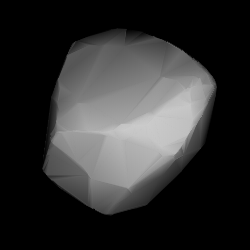Astronomy:1457 Ankara
 Shape of Ankara modelled from its lightcurve | |
| Discovery[1] | |
|---|---|
| Discovered by | K. Reinmuth |
| Discovery site | Heidelberg Obs. |
| Discovery date | 3 August 1937 |
| Designations | |
| (1457) Ankara | |
| Named after | Ankara (Turkish capital)[2] |
| 1937 PA · 1933 SA 1934 XG · 1936 FL1 1943 YD · 1966 BG | |
| Minor planet category | main-belt · (middle)[3] |
| Orbital characteristics[1] | |
| Epoch 16 February 2017 (JD 2457800.5) | |
| Uncertainty parameter 0 | |
| Observation arc | 82.95 yr (30,296 days) |
| |{{{apsis}}}|helion}} | 3.1134 AU |
| |{{{apsis}}}|helion}} | 2.2802 AU |
| 2.6968 AU | |
| Eccentricity | 0.1545 |
| Orbital period | 4.43 yr (1,618 days) |
| Mean anomaly | 63.234° |
| Mean motion | 0° 13m 21.36s / day |
| Inclination | 6.0913° |
| Longitude of ascending node | 296.31° |
| 296.31° | |
| Physical characteristics | |
| Dimensions | 17.834±0.207 km[4] 18.495±0.068 km[5] 18.95±0.63 km[6] 19.82±0.26 km[7] 29.08 km (calculated)[3] |
| Rotation period | 31.8±0.6 h[8] |
| Geometric albedo | 0.1 (assumed)[3] 0.258±0.051[6] 0.262±0.008[7] 0.3038±0.0536[5] 0.320±0.037[4] |
| S[3] | |
| Absolute magnitude (H) | 10.60[7][5] · 10.70[6] · 10.8[1][3] |
1457 Ankara, provisional designation 1937 PA, is a stony asteroid from the central region of the asteroid belt, approximately 18 kilometers in diameter. It was discovered on 3 August 1937, by German astronomer Karl Reinmuth at Heidelberg Observatory in southwest Germany, and later named for the Turkish capital city of Ankara.[2][9]
Orbit and classification
Ankara orbits the Sun in the middle of the main-belt at a distance of 2.3–3.1 AU once every 4 years and 5 months (1,618 days). Its orbit has an eccentricity of 0.15 and an inclination of 6° with respect to the ecliptic.[1] It was first observed as 1933 SA at Uccle Observatory in 1933, extending the body's observation arc by 4 years prior to its official discovery observation at Heidelberg.[9]
Physical characteristics
Rotation period
A rotational lightcurve of Ankara was obtained from photometric observations by French amateur astronomer René Roy in September 2004. Lightcurve analysis gave a rotation period of 31.8 hours with a brightness variation of 0.21 magnitude ({{{1}}}).[8] While not being a slow rotator, Ankara's spin rate is slower than that of most asteroids, which typically rotate within 20 hours once around their axis.
Diameter and albedo
According to the surveys carried out by the Japanese Akari satellite, and NASA's Wide-field Infrared Survey Explorer with its subsequent NEOWISE mission, Ankara measures between 17.834 and 19.82 kilometers in diameter and its surface has an albedo between 0.258 and 0.320.[4][5][6][7]
The Collaborative Asteroid Lightcurve Link (CALL) assumes a lower albedo of 0.10 – a compromise value that lies between the albedos for stony (0.20) and carbonaceous (0.057) asteroids, chosen by CALL for all non-family asteroids with a semi-major axis between 2.6 and 2.7 AU – and consequently calculates a larger diameter of 29.08 kilometers with an absolute magnitude of 10.8, as a body's diameter and albedo are inversely related to each other.[3]
Naming
This minor planet was named after the Turkish capital Ankara. The official naming citation was proposed by Wolfgang Gleißberg, a German Solar astronomer, who immigrated to Turkey, after he was dismissed at the Breslau Observatory in Nazi Germany in 1933, because he had a Jewish grandfather. The citation was first mentioned in The Names of the Minor Planets by Paul Herget in 1955 (H 131).[2][10]
References
- ↑ 1.0 1.1 1.2 1.3 "JPL Small-Body Database Browser: 1457 Ankara (1937 PA)". Jet Propulsion Laboratory. https://ssd.jpl.nasa.gov/sbdb.cgi?sstr=2001457. Retrieved 27 April 2017.
- ↑ 2.0 2.1 2.2 Schmadel, Lutz D. (2007). "(1457) Ankara". Dictionary of Minor Planet Names – (1457) Ankara. Springer Berlin Heidelberg. p. 117. doi:10.1007/978-3-540-29925-7_1458. ISBN 978-3-540-00238-3.
- ↑ 3.0 3.1 3.2 3.3 3.4 3.5 "LCDB Data for (1457) Ankara". Asteroid Lightcurve Database (LCDB). http://www.minorplanet.info/PHP/generateOneAsteroidInfo.php?AstInfo=1457%7CAnkara. Retrieved 27 April 2017.
- ↑ 4.0 4.1 4.2 Masiero, Joseph R.; Grav, T.; Mainzer, A. K.; Nugent, C. R.; Bauer, J. M.; Stevenson, R. et al. (August 2014). "Main-belt Asteroids with WISE/NEOWISE: Near-infrared Albedos". The Astrophysical Journal 791 (2): 11. doi:10.1088/0004-637X/791/2/121. Bibcode: 2014ApJ...791..121M. http://adsabs.harvard.edu/cgi-bin/bib_query?bibcode=2014ApJ...791..121M. Retrieved 27 April 2017.
- ↑ 5.0 5.1 5.2 5.3 Mainzer, A.; Grav, T.; Masiero, J.; Hand, E.; Bauer, J.; Tholen, D. et al. (November 2011). "NEOWISE Studies of Spectrophotometrically Classified Asteroids: Preliminary Results". The Astrophysical Journal 741 (2): 25. doi:10.1088/0004-637X/741/2/90. Bibcode: 2011ApJ...741...90M.
- ↑ 6.0 6.1 6.2 6.3 Masiero, Joseph R.; Mainzer, A. K.; Grav, T.; Bauer, J. M.; Cutri, R. M.; Nugent, C. et al. (November 2012). "Preliminary Analysis of WISE/NEOWISE 3-Band Cryogenic and Post-cryogenic Observations of Main Belt Asteroids". The Astrophysical Journal Letters 759 (1): 5. doi:10.1088/2041-8205/759/1/L8. Bibcode: 2012ApJ...759L...8M. http://adsabs.harvard.edu/cgi-bin/bib_query?bibcode=2012ApJ...759L...8M. Retrieved 27 April 2017.
- ↑ 7.0 7.1 7.2 7.3 Usui, Fumihiko; Kuroda, Daisuke; Müller, Thomas G.; Hasegawa, Sunao; Ishiguro, Masateru; Ootsubo, Takafumi et al. (October 2011). "Asteroid Catalog Using Akari: AKARI/IRC Mid-Infrared Asteroid Survey". Publications of the Astronomical Society of Japan 63 (5): 1117–1138. doi:10.1093/pasj/63.5.1117. Bibcode: 2011PASJ...63.1117U. (online, AcuA catalog p. 153)
- ↑ 8.0 8.1 Behrend, Raoul. "Asteroids and comets rotation curves – (1457) Ankara". Geneva Observatory. http://obswww.unige.ch/~behrend/page4cou.html#001457. Retrieved 27 April 2017.
- ↑ 9.0 9.1 "1457 Ankara (1937 PA)". Minor Planet Center. https://www.minorplanetcenter.net/db_search/show_object?object_id=1457. Retrieved 27 April 2017.
- ↑ Angelika Rieber. "Wolfgang Gleissberg – Refuge in Turkey". Project Jewish Life in Frankfurt. http://www.juedisches-leben-frankfurt.de/english/home/biographies-and-encounters/biographies-g-l/wolfgang-gleissberg.html. Retrieved 27 April 2017.
External links
- Asteroid Lightcurve Database (LCDB), query form (info )
- Dictionary of Minor Planet Names, Google books
- Asteroids and comets rotation curves, CdR – Observatoire de Genève, Raoul Behrend
- Discovery Circumstances: Numbered Minor Planets (1)-(5000) – Minor Planet Center
- 1457 Ankara at AstDyS-2, Asteroids—Dynamic Site
- 1457 Ankara at the JPL Small-Body Database
 |

